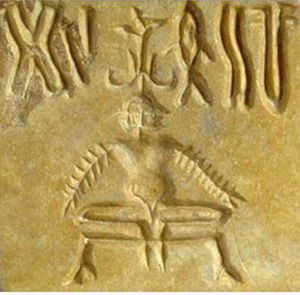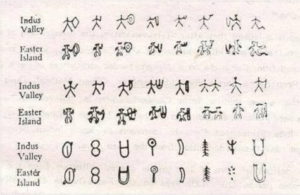My India

 I grew up wanting to know and for some reason I could never accept what was presented as truth in our social history and my schoolbooks. I also wanted to know the why of some mystical experiences I was having and find some context.
I grew up wanting to know and for some reason I could never accept what was presented as truth in our social history and my schoolbooks. I also wanted to know the why of some mystical experiences I was having and find some context.
Like most young people I was confused by the bigotry and double standards displayed by social representatives so I learned to walk lightly. My journey eventually led to India where I was filled by its chaotic colour, fragrance and joy amid hardship. As I looked more deeply, I came to realise that Hindu civilisation had been severely damaged, raped and plundered for over a thousand years yet it still flourished whereas Western civilisation built on supposedly high morals seems doomed to failure.
This is because Hindu civilisation is built on the tangible reality that we are spiritual beings, we are the soul with a body and mind living in environment which is continually changing or impermanent. In contrast, Western civilisation is built upon the belief that we are the physical body/mind and the physical world is permanent.
I began to wonder how the Western world had got things so badly wrong and after reading the book ‘Culture, People and Nature’, a text on civilisational development with mention of Earth changes, I knew I had to research history. That was slow going until the Internet arrived and now the truth is emerging.
Darwin was partly right but the accepted theories of how we came to be as we are not exactly correct and the truth may never be known. Looking back to 100,000 BC there were many humanlike populations around the world – in Africa, southern Europe, Central Asia, India and Southeast Asia and also likely in the Americas. These peoples all contribute to our make up today but the real home of civilisation is the land we know as India which has always been central to the human story.
Modern archaeologists and anthropologists are attached to their theories, ideas that comes from a basic failure to appreciate life. This means the out of Africa theory is completely wrong and we must also take into account changes in sea level and climate as we evaluate history, our reason for being and how we organise ourselves as a society.
“Narmada Nensis proved the presence of early humans in the Indian subcontinent. This scientific finding represents a human form that had colonised India at least 350,000~275,000 years ago. ” ~ D K Bhattacharya
A key point in history occurred around seventy-five thousand BC when Mount Toba in Sumatra erupted covering India in a layer of ash. There is evidence of human habitation before and after this eruption signifies that the people living there continued to survive and indeed thrive. The civilisation that was developing was practical and concerned with long-term survival at a physical level, but it was also interested in the metaphysical or the spiritual dimension of existence which gave rise to the elements of what is referred to as modern day
Hinduism.
It is not known how much travel and communication there was between peoples prior to the last ice age but a clue has been found in Germany in the form of a Hindu idol dated to 35,000 BC. While the object itself could not be dated the soil that it was buried in was datable. The fact that this artefact was found in Germany proves there was travel and the existence of the artefact proves that what we call as Hinduism was flourishing with those ideas being exported.
As ice covered the northern hemisphere and the sea levels dropped people were more able to move between major landmasses on foot or make their way between low-lying chains of islands in simple boats. During this period of climatic uncertainty, many northern groups would have been forced to move south to find means of survival but this would have had little effect on India. But we know it had a detrimental effect on the Neanderthal population which went extinct though they live on in modern populations because they interbred.
With the lower sea levels, what is now the continental shelf around India became populated and we know this because there are extensive remains of ancient cities. During the Younger Dryas some ten-eleven thousand years ago, those populations were forced further inland and it is likely that these people were absorbed into existing population centres, built anew or migrated to other regions. I think this is also the time when Indian understanding really moved out into the world and helped to shape neighbouring civilisations before
capitalism made this debut.
At this time we know Hindu civilisation was well-developed from the evidence in the Indus Valley and across north-west India. We know this population was relatively peaceful because there is little evidence of fortification. There is more evidence supporting the idea that there was a major movement underway to understand one’s place in the cosmos and the nature of existence as indicated in yogic seals, the development of the Sanskrit language, science, technology and agriculture.
In this period around ten thousand BC it would be fair to say India was in fact flourishing. Shiva who was attributed as being the first yogi (around fourteen thousand BC) had explained the technology of being human and the Saptarishies carried this knowledge to the corners of the earth. Within India that task was carried out by Agastya Muni who was supported by countless men and women who practised yoga and had the insight.
Thus Sanatana Dharma, a way of living in harmony with nature while supporting human wellbeing came into being. This human culture addressed all physical and spiritual needs against the constantly changing environment and the vagaries of the human condition. By five thousand BC Sanatana Dharma was the primary influence from the Mediterranean to the Pacific. There are stories of Hindu warships of the time but these pale in comparison to the number of stories of the great trading ships that sailed across the Pacific. It is now clear that there had to be some communication between the Indus Valley civilisation and Easter island as the script found in both places is so similar.

There is a great deal of evidence supporting the arrival of Hindu culture in the Americas. The Mayan calendar that so many feared predicted the end of the world in twenty twelve bears close resemblance to Hindu calendars and we have the mythology surrounding the construction of great monuments all over the world as being either built or designed by Hindus.
There is so much evidence coming to light that it’s impossible to make any complete list that we have the evidence of Hindu DNA in the Australian aboriginal population (4000 BC) and the New Zealand Maori (1800 A.D.). In Egypt cattle became an object of veneration around 5000 BC about which time climate change and history began to have an more unfortunate impact.
The Sahara, North India and parts of central Asia were drying and population groups began moving, some up into central Asia, some to the south and others west through the Mediterranean and on to coastal settlements in Western Europe were traces of their DNA can be found today.
It is thought that Hindu civilisation to this point had been communal with a class structure appropriate for any civilisation with roles/occupations according to one’s ability. But there would have been kingdoms and isolated communities all functioning under the auspices of Sanatana Dharma. There is no doubt that life wouldn’t have been particularly easy, there would have been floods and famines, conflicts and diseases, but there was also a willingness to seek out and apply remedies to social problems based on the precept that we are all participants in an equal opportunity evolutionary process with the end goal being self realisation and liberation from all forms of suffering.
The nature of civilisation itself was towards freedom of suffering and the freedom to explore ideas. The sciences of medicine, astronomy, metallurgy, agriculture and others were well-developed and being exported along with the technology of being human which gave rise to the cultural sophistication we see across the ancient world while in Europe the people were still hunter gatherers fighting over territory and creating scores (karma) to settle.
The IVC was using a form of money to facilitate trade and as this idea began to spread it created misfortune. The legend goes that a Persian king woke up one morning and decided that his suffering was not his fault but the fault of his wife. He also had the idea that money could buy happiness and these two forces became as one. Money as a means of acquisition; patriarchy diminishing woman combined to form capitalism.
Note: the Aryan invasion/migrations theories have been disproved. “DNA study of the skeletal remains found at the Harappan site of Rakhigarhi, Haryana, shows no Central Asian trace, indicating the Aryan invasion theory was flawed and Vedic evolution was through indigenous people.” ~ The Economic Times
This contagion spread back into India and began to weaken society by creating divisions which upset the way of life. The stories in the Mahabharata played out and capitalism (the story of Omar) began to dominate with debt slavery emerging as it did in other countries.
By twenty-six hundred BC when Buddha arrived on the scene, he was appalled at the level of suffering, the disproportionate sharing of wealth and resources and it’s reported that he spoke out against the social structure. But this was also a time of great learning, population growth and the construction of educational facilities.
While Sanatana Dharma continued to support life across South India, Buddhism spread across the North, into Europe and South East Asia replacing Sanatana Dharma. Block printing along with predominantly Buddhist manuscripts were exported and transcribed into Chinese to enrich Chinese culture.
With growing international trade, Hindu ideas began to awaken the Greeks and Romans as they had the Egyptians, Persians and Arabs several millennia before. While Hinduism continued to flourish in the east, the west began to awaken and absorb Hindu knowledge blended together with capitalism which would be pitched against intertribal conflict that had been going on for centuries.

Twelve hundred years ago Islam emerged and fuelled by a philosophy of hatred towards any nonbeliever, they wiped out the peaceful Buddhists who were in no position to defend themselves. Islam never completed their conquest because built into Sanatana Dharma had a very good defence mechanism which has survived against all odds yet things were about to get worse.
The Europeans did not have the capacity to understand the nature of the one God even though Jesus tried to explain to them and they made religion as a tool for social and political control effectively divorcing from the Hindu sense of spirituality. But they took Hindu knowledge and built on top of it which led to the burst of scientific discoveries that we’ve seen in the past few hundred years.
Vasco de Gama was the first European to sail to India and naively it was Hindu sailors who guided him across from Africa. He was only seeking material wealth and from then on India was systematically exploited primarily by the British who not only took the wealth of India, they starved the people and made them pay for British expenses during the first and second world Wars.
It’s estimated that the Muslims and the British are responsible for the deaths of millions of Hindus. And please remember that the word Hindu is not a religion, the land was once known as Hindustan and the term along with caste (a copy of the English class system) were coined by the British.
Ancient India and the neighbouring lands that lived relatively harmoniously under the guidance of Sanatana Dharma were subdivided and administered by colonialists: capitalist forces intent on plunder and then took control to exploit the wealth and resources.
Modern India is re-emerging and yet the world seems to look on India through distorted lenses because these have been arranged by the British who rewrote Indian history to conform to their own ideas even though they are still trying to understand the wonder and complexity of Hindu science as they continue to use that knowledge to propel new scientific breakthroughs and the inventions of new technologies.
If there had been no India and no Sanatana Dharma, it seems unlikely that Europe could have evolved beyond being primitive agriculturalists. The English could never accept that they failed to make India completely their own, they are frustrated that those damn Wogs as referred to Hindus were never beaten into submission even though their culture was almost destroyed and has been completely corrupted.
“Brahmins WERE the cement that held the many nations and religions of Bharatha Varsha together with Dharma till 1921 when a legal fiction called “Hindooism” was created. The cement has been eradicated with greater viciousness and precision since 1947.” ~ S Suchindranath Aiyer
Today the Britishness that they left behind continues to do the destructive work setting the people against each other because this was the British mandate, dividing control. The other element intent on destroying India and the planet is capitalism because it is abstract, unprincipled and only serves the one who has the most. If ever there was a doomsday machine, it’s name must be
capitalism.
Despite all the destruction and loss of life, enough Hindus continue to meditate and inspire each other in the ancient traditions and those traditions are being both stolen and exported. Here I am referring to the science of yoga which is the science of how to become fully human.
It is only through yoga and meditation that any individual can know themselves as being a part of life and as a part of the cosmos. These mystical practices are so delightfully rational that they appear irrational to the mind that wants to possess and control. It’s almost like it’s a cosmic joke that those who are so desperately seeking happiness outside of themselves through acquisition and possession are denying themselves the only real happiness that is possible.
It seems somehow ironic that the British who believe in their own superiority and continue to ostracise India yet are so deeply indebted to India, they have in their midst Hindu communities and Sanatana Dharma is flourishing. It’s a question of time as to whether or not Sanatana Dharma will emerge strongly enough to cool down all the hotheads intent on global domination through political, militaristic or economic means.
My India is a land of colour and contrast, a place where human civilisation began and despite the outside interference and internal conflicts, she continues to be a source of inspiration and guidance. The wisdom of India represents the only hope for humanity’s survival and if the world pays no heed, we shall perish.
DISCLAIMER: The author is solely responsible for the views expressed in this article. The author carries the responsibility for citing and/or licensing of images utilized within the text.
